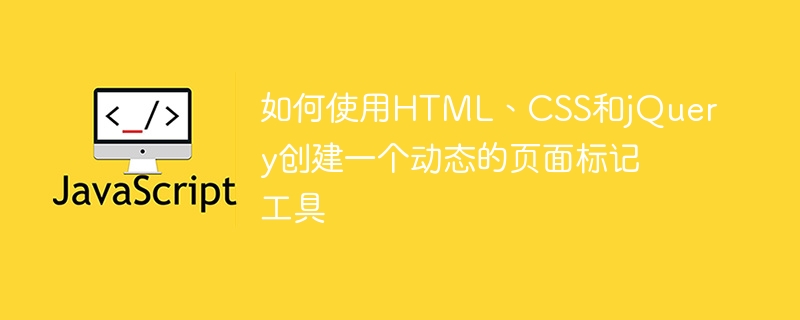

How to use HTML, CSS and jQuery to create a dynamic page markup tool
Introduction:
In today's Internet era, webpage markup tools are very important One of the tools. It can provide users with a friendly and intuitive way to create, edit and mark up web content. In this article, we'll learn how to use HTML, CSS, and jQuery to create a powerful and flexible dynamic page markup tool.
1. HTML structure design:
We first need to design the HTML structure to build the basic framework of the page markup tool. Here is a simple example:
<!DOCTYPE html>
<html>
<head>
<meta charset="UTF-8">
<title>动态页面标记工具</title>
<link rel="stylesheet" type="text/css" href="styles.css">
</head>
<body>
<div class="toolbar">
<button id="bold">加粗</button>
<button id="italic">斜体</button>
<button id="underline">下划线</button>
</div>
<div class="content" contenteditable="true">
<p>在这里输入你的内容...</p>
</div>
<script src="jquery.min.js"></script>
<script src="script.js"></script>
</body>
</html>In this example, we have a toolbar (toolbar) and an editable content area (content). The toolbar contains buttons for bold, italics, and underline. A content area allows users to type and edit content.
2. CSS style design:
When creating a markup tool, we also need some CSS styles to beautify and layout the page. Here is a simple style example:
.toolbar {
background-color: #ccc;
}
.toolbar button {
font-weight: bold;
color: #333;
background-color: #ccc;
border: none;
padding: 5px 10px;
margin: 5px;
}
.content {
width: 800px;
height: 400px;
border: 1px solid #ccc;
padding: 10px;
margin: 20px auto;
}In this example, we define the style of the toolbar, which has a gray background and a 5px spacing between buttons. We also define the style for the content area, which has a width of 800 pixels and a height of 400 pixels, as well as some borders and inner and outer margins.
3. jQuery interaction design:
By using jQuery, we can easily add interactive functions to the page markup tool. Here's a simple example:
$(document).ready(function() {
$('#bold').click(function() {
$('.content').toggleClass('bold');
});
$('#italic').click(function() {
$('.content').toggleClass('italic');
});
$('#underline').click(function() {
$('.content').toggleClass('underline');
});
});In this example, we first add an event handler when the document is ready. We then added a click event handler for each button. When the button is clicked, we use the .toggleClass() method to add the .bold, .italic, and .underline classes to the .content element to achieve the corresponding markup effect.
4. CSS class style design:
Finally, we need to define the .bold, .italic and .underline class styles to achieve the corresponding text mark effect. The following is a simple example:
.bold {
font-weight: bold;
}
.italic {
font-style: italic;
}
.underline {
text-decoration: underline;
}In this example, we define the .bold class to set the bold effect of the text, the .italic class to set the italic effect of the text, and the .underline class to set the underline of the text. Effect.
Summary:
By using HTML, CSS and jQuery, we can easily create a dynamic page markup tool. By designing appropriate HTML structure and CSS styles, and using jQuery to add interactive features, we can provide users with a friendly and intuitive way to create, edit, and markup web content. I hope this article was helpful and I wish you success in creating a page markup tool!
The above is the detailed content of How to create a dynamic page markup tool using HTML, CSS and jQuery. For more information, please follow other related articles on the PHP Chinese website!